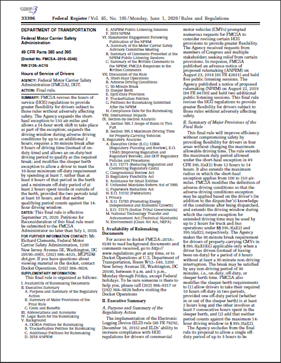Is That Truck Driver Safe?
Is That Truck Driver Safe?
Have you ever wondered, as you passed a heavy truck on the interstate, whether that driver was on top of his game or not, that is, is he as alert as he should be to operate that 18-wheeler?

I once had a temporary job for one summer, while attending college in Raleigh, North Carolina routing delivery trucks that ranged in size from local box trucks to larger semi-trailer trucks for longer hauls. I had to keep in mind as I scheduled the trucks, not only their cargo-carrying capacities but also how long the truck driver would be driving and make sure I got him back to home base early enough that he could be loaded up to make a delivery the following day. There are many, seemingly complex hours-of-service rules that are supposed to assure commercial truck drivers remain alert while they operate their semi-trailer trucks with cargo.
These rules are found in the US Department of Transportation (DOT), Federal Motor Carrier Safety Administration's (FMCSA), Code of Federal Regulations (CFR), Title 49, Part 395.

This is a 57-page document that covers many situations, scenarios, and contains a host of exceptions for drivers, such as sleeper berth and adverse weather provisions. One summary of these requirements for commercial and passenger-carrying drivers, which is available in handbooks, flyers and through many public channels, contains verbiage similar to the following:
Commercial Truck Driver Rest Requirements, Property carrier:
- 11-hour limit: May drive a maximum 11 hours after 10 consecutive hours off duty
- 14-hour limit: May not drive beyond the 14th consecutive hour after coming on duty.
- Truck drivers must take at least one 30-minute break after 8 hours of driving
- Truck drivers cannot drive more than 60 hours in a seven-day period, or 70 hours in an eight-day period (60/70-hour duty limit)
- Truck drivers may restart the 60/70-hour duty limit after they go off duty for 34 straight hours (34-hour restart rule).
- Sleeper berth provision: The 10-hour off-duty period may be split into at least 2 hours non-driving time and 7 hours sleeper berth time.
- Adverse Driving Provision: Drivers are allowed to extend the 11-hour maximum driving limit and 14-hour driving window by up to 2 hours
- Short-Haul Exception: driver exempt if operating within a 150-mile radius of the normal work reporting location, and the driver does not exceed a 14-hour duty period.
An easy way to remember all of this and assure compliance in most cases can be summarized in two sentences:
Maximum 11 hours driving in a 14-hour duty period, then 10 hours off (Note: 14 +10 =24). A 30-minute break is required after 8-hours of driving.
Just keep in mind that not all circumstances and exceptions are covered in this one statement, and the official document should be reviewed for specific applications. I eventually wrote a computer program in DOS, complete with disclaimers, that would help my mentor and boss more easily adhere to these simplified requirements after I left that workplace and returned to my university studies.

My boss was completely thrilled with the program’s performance, and I have sometimes wondered what eventually became of its use.
About the Author
G. Wayne Maltry, AMT, BSAE, MSME, PE is a consulting engineer with our Columbia, SC office. Mr. Maltry provides consulting services in the following areas: fracture and failure analysis, including finite element analysis; aircraft crash and vehicle collision investigation and reconstruction; origin and cause of air and land vehicle, structure and equipment fires; machinery scope of damages; assessment of appliances, machinery, vehicles and equipment (including HVAC); evaluation and analysis of process equipment, plumbing and piping; industrial accident analysis; and lightning damage assessment. You may contact Wayne for your forensic engineering needs at wmaltry@edtengineers.com or (803) 791-8800.
Learn about how EDT Forensic Engineering & Consulting approaches cause of damage, and forensic engineering by assigning a file today.

